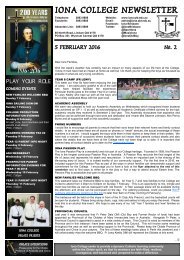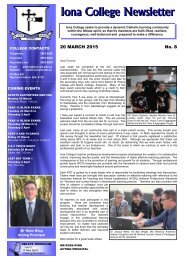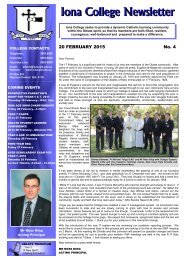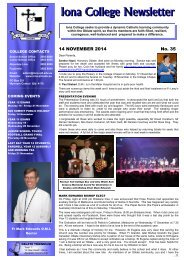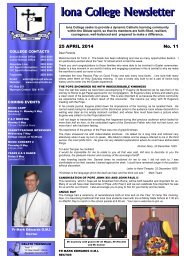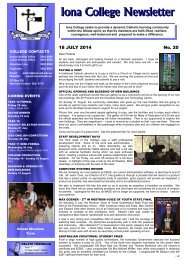IONA COLLEGE NEWSLETTER
19a_2016
19a_2016
You also want an ePaper? Increase the reach of your titles
YUMPU automatically turns print PDFs into web optimized ePapers that Google loves.
FROM THE RECTOR cont...<br />
CATHOLIC SCHOOLS PARENTS AUSTRALIA<br />
This weekend I travel to Perth for a committee meeting of this group. I was asked by the Catholic Bishops to provide pastoral and spiritual support to<br />
this National Committee and it is something that I gladly support. There are some very important resources that can be very helpful to families to be<br />
found at the Catholic School Parents Australia website and I encourage you to have a look if you get the chance.<br />
INTRODUCING CANNON HILL – 4170<br />
Cannon Hill, a residential suburb on Wynnum Road, is 5 km in a direct line from central Brisbane,<br />
although longer by rail and road.<br />
Unlike many Brisbane suburbs, it seems the derivation of the name 'Cannon Hill' is quite clear - and its<br />
meaning is surprisingly literal. The Cannon Hill area was named by Lands Department surveyors after<br />
seeing fallen trees that resembled guns or cannons. "It's as simple as that," says Brian Randall from<br />
the State Library of Queensland.<br />
The name was further cemented when the residence on an adjacent estate, established by the<br />
Weedon family, was named 'Cannon Hill House' (photographed), which featured extensive grounds,<br />
including a maze. This residence was built in 1867.<br />
In 1881, the Queensport Freezing and Food Export Company produced the first frozen meat there and<br />
this started Cannon Hill's meat industry focus. Cannon Hill would later house the CSIRO Meat<br />
Research Laboratory until its closure in 1992.<br />
In 1889 the railway to Cleveland was opened and, anticipating a demand for blocks of land near the station, an estate was put on the market.<br />
Ballistic-sounding “Shrapnel”, “Gatling” and “Grenade” Roads mark the place. As an investment, the estate did not ignite.<br />
In 1913 the Swift Company built a meatworks near the river, north of Cannon Hill, and in 1915 the Cannon Hill primary school was opened. A school<br />
of arts was opened at the corner of Barrack and Wynnum Roads where a small shopping centre would grow.<br />
The Swift enterprise employed 300 people during its construction and was an important source of local employment. In 1931 it was acquired by the<br />
government for the Metropolitan Public Abattoir Board, and a saleyard and holding pens were constructed. The complex, including several<br />
wholesale butchery and meat exporters, extended from the railway line to the abattoir on the river, a distance of 2 km, traversed by a spur line. It<br />
replaced the saleyard at Newmarket.<br />
In 1931, the Cannon Hill saleyards opened and they became the state's major cattle, sheep and<br />
pig-selling centre. They closed in 1991 and now are home to high-density housing. Nearly a million<br />
head of stock were sold in the first year. Many stockmen and their families lived in the area and during<br />
the Great Depression itinerant workers had a camp on the corner of Creek and Richmond roads, with<br />
huts made of flattened kerosene tins.<br />
During 60 years of operation the Cannon Hill Saleyard sold livestock from most of Queensland<br />
(sometimes bypassing Rockhampton and Dalby), Northern Territory and South Australia. It was a<br />
modern facility with sealed surfaces, important during outbreaks of stock diseases. During the 1980s<br />
inland and New England saleyards competed more effectively, and a feedlot facility gained a putrid<br />
reputation within smelling distance of suburbia. Locals will well remember the smells of Cannon Hill and<br />
surrounding suburbs. The saleyard was closed in 1991 and the land was turned over to housing and<br />
an office park. The saleyard's handsome two-storey double veranda administration building has been<br />
re-constructed at the Mount Gravatt showground.<br />
Until the 1960s Cannon Hill was based around the intersection of Wynnum and Barrack Roads, with about eight stores, a post office, the school of<br />
arts, Catholic (St Oliver Plunkett’s) and Presbyterian churches and the St Oliver Plunkett Catholic School (1946) to the west. The village centre<br />
received a series of blows in the 1970s when three drive-in shopping centres were opened on Wynnum Road, about a kilometre to the east. One of<br />
them had a Waltons discount department store, whose site was absorbed by Kmart Plaza when the Waltons-Bond empire<br />
collapsed. A very interesting fact is that the Kmart at Cannon Hill was the first Kmart in Queensland and the McDonalds in<br />
Cannon Hill was among the first in Queensland.<br />
Cannon Hill was also home to a drive-in theatre where Bunnings is currently located. Many people saw their first movie<br />
at this place.<br />
Cannon Hill Anglican College on Krupp Road opened in 1989.<br />
The Beattie Labor government built an emergency response complex at Cannon Hill to house fire, ambulance, chemical<br />
and major disaster planning units in 2004.<br />
Bill Cash memorial Park is home to Netball and the Cannon Hill Stars Rugby League Club. The most<br />
famous “Star” to come from Cannon Hill was Wally Lewis (Valleys, Wynnum Manly, Queensland and<br />
Australia). King Wally as he is affectionately known is one of Queensland’s finest players (representing<br />
Queensland on 31 occasions and captain of 30 with 8 Man of the Match awards).<br />
Also housed in modern Cannon Hill is the Queensland headquarters of National Archives Australia, protecting the<br />
commonwealth heritage of Australia. On this site was also a base during World War II of the US Army 391 st Engineering<br />
Corps.<br />
Take Care and God Bless<br />
FR MICHAEL TWIGG O.M.I.<br />
RECTOR<br />
Cannon Hill is also experiencing urban renewal at the sites of former<br />
research laboratories on the corner of Creek Road and Wynnum Road.<br />
Judging by the picture left, its future looks very bright.<br />
The foundation of St Oliver Plunkett’s Catholic Church was held in 1921 by<br />
Archbishop Duhig. Iona College has had a link with the students of Cannon<br />
Hill since our earliest foundations with Gary Coghill being one of its finest<br />
examples. Our relationship with St Oliver Plunkett’s Catholic School is<br />
incredibly strong and a significant number of enrolments come to the College<br />
each and every year. There are in fact many staff members of the College<br />
who have also come from St Oliver Plunkett’s as well as many parents. As<br />
you can see from the information above, Cannon Hill has a long and varied<br />
history and a bright and prosperous future. We are very appreciative of the<br />
relationship with Cannon Hill and look forward to it continuing to grow.




